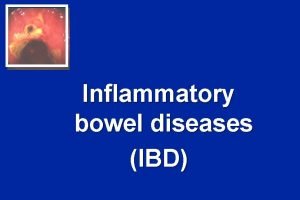CATEGORY PATHOGENS DISEASE ULCERATIVE COLITIS AND TRICHURIS INFECTION

- Slides: 1

CATEGORY: PATHOGENS & DISEASE ULCERATIVE COLITIS AND TRICHURIS INFECTION Ulcerative colitis and. Trichuris infection Ekta Bhardwaj, University of Manchester, UK IBD is influenced by various factors • Geographical location: common in North America, Northern and Western Europe, less in South Africa, Australia, and South and Middle Europe and rare in Asia and Africa. Altered immune response and Hygiene Hypothesis IBD • Racial influence: common in Jewish population. • Genetic mutations: TLR 4, MDR 1, NOD 1 (CARD 4), DLG 5 mutations are linked with the IBD. Gut microflora and epithelial disruption Genetic mutations Racial factors Environmental factors • Gut luminal commensal bacterias and impaired epithelial gut barrier are also linked to the occurrence and exacerbation of colitis. Factors influencing the occurrence and exacerbation of IBD • Altered immune response. Colitis Large intestine post-Trichuris infection According to the ‘Hygiene Hypothesis’, IBD occurs more commonly where intestinal helminth infestation is low. Clinical trials show Trichuris suis can effectively reduce/ameliorate the inflammation of the colon in humans. The exact mechanism of action is not yet known, possibly T. suis induces the T regulatory cells in the host which controls the inappropriate immune response. © The copyright for this work resides with the author Inflammatory bowel disease (IBD) comprises a group of idiopathic chronic relapsing inflammatory conditions of the gastrointestinal tract. IBD commonly involves two conditions, ulcerative colitis and Crohn’s disease. Ulcerative colitis mainly affects the colon, whereas Crohn’s disease can involve any part of the intestine. IBD may present as abdominal pain, diarrhoea, rectal bleeding, strictures and fibrosis. The precise aetiology for both the diseases is unknown. Inflammatory bowel disease usually manifests in the second or third decades of life. However, there is another peak in incidence in the sixties.

